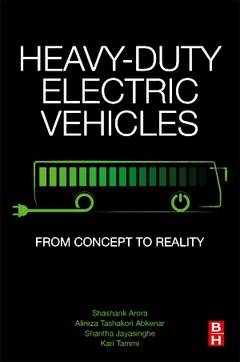Description
Heavy-Duty Electric Vehicles
From Concept to Reality
Authors: Arora Shashank, Tashakori Abkenar Alireza, Jayasinghe Shantha Gamini, Tammi Kari
Language: English
Subject for Heavy-Duty Electric Vehicles:
Keywords
Zero emission vehicles; electric buses; energy policy; optimal EV design; design regulations; electric motor; EV drivetrain; EV drivetrain parameterisation; HV battery packaging; thermal management; system diagnostics; EV supervisory control; fast (inductive) charging; vehicle to grid power transfer; battery management system; fault-tolerant control systems; wireles
164.01 €
In Print (Delivery period: 14 days).
Add to cart256 p. · 15x22.8 cm · Paperback
Description
/li>Contents
/li>Readership
/li>Biography
/li>Comment
/li>
Heavy-Duty Electric Vehicles: From Concept to Reality presents a step-by-step design and development guide for heavy-duty electric vehicles. It also offers practical insights based on the commercial application of an electric city bus.
Heavy-duty electric vehicle design is challenging due to a lack of clear understanding of the government policies, R&D directions and uncertainty around the performance of various subsystems in an electric powertrain. Therefore, this book discusses key technical aspects of motors, power electronics, batteries and vehicle control systems, and outlines the system integration strategies necessary for design and safe operation of electric vehicles in practice.
This comprehensive book serves as a guide to engineers and decision makers involved in electric vehicle development programs and assists them in finding the suitable electric powertrain solution for a given heavy-duty vehicle application.
1. Heavy-duty Electric Vehicles and Society2. Drivetrains Configurations for Heavy-duty Electric Vehicles3. Electric Motor Drives for Heavy-duty Electric Vehicles4. Materials and Manufacturing Methods for Advanced Li-ion Batteries5. EV Battery Pack Engineering: Electrical Design and Mechanical Design6. Charging Technologies and Standards Applicable to Heavy-duty Electric Vehicles7. Drivetrain Control System in Heavy-duty Electric Vehicle Applications8. Battery Management System: Charge Balancing and Temperature Control9. Supervisory Control Systems for Heavy-duty Electric Vehicles10. Technology Roadmap for Heavy-duty Electric Vehicles
EV system design, integration and application engineers; Masters & postgrads in Mechatronics/Machine design, electrical machines, automotive engineering, and energy systems design. Formula SAE teams and other students working on EV related final year projects
Alireza Tashakori Abkenar is the EV Application Manager at MoTeC, Melbourne, Australia. He has successfully led multiple heavy-duty EV development projects including the Matilda Gen II Electric City Bus, which passed all the Australian Design Rules (ADR). He is currently focusing on EV drivetrain system and supervisory control design and integration of electric race cars in Australia and overseas.
Shantha Gamini Jayasinghe is a Senior Lecturer at the Australian Maritime College, University of Tasmania, Australia. Shantha’s research interests include power electronic converters, renewable energy technologies, grid integration of energy systems, shipboard power systems, electric propulsion and electric vehicles.
Kari Tammi is an Associate Professor at the School of Engineering, Aalto University, Espoo, Finland and the Chief Engineer Counselor of the Finnish Administrative Supreme Court. He is the Deputy Chair for IFTOMM Finland, and a member of IEEE and the Finnish Academy of Technology.
- Offers an overview of various standards and regulations that guide the electric vehicle design process and a comprehensive discussion on various government policies and incentive schemes propelling the growth of heavy electric vehicle markets across the world
- Provides a comparative evaluation of different electric drivetrain concepts and a step-by-step power calculation guide for heavy-duty electric powertrain
- Explains material selection and manufacturing methods for next generation batteries
- Discusses key elements and design rules for creating a robust high voltage energy storage system, appropriate packaging and its support systems including charging network
- Includes a concise description of torque mapping, power management and fault handling strategies for inverter drive and control systems
- Features case studies to better understand complex topics like charging system requirements and vehicle control system diagnostics




